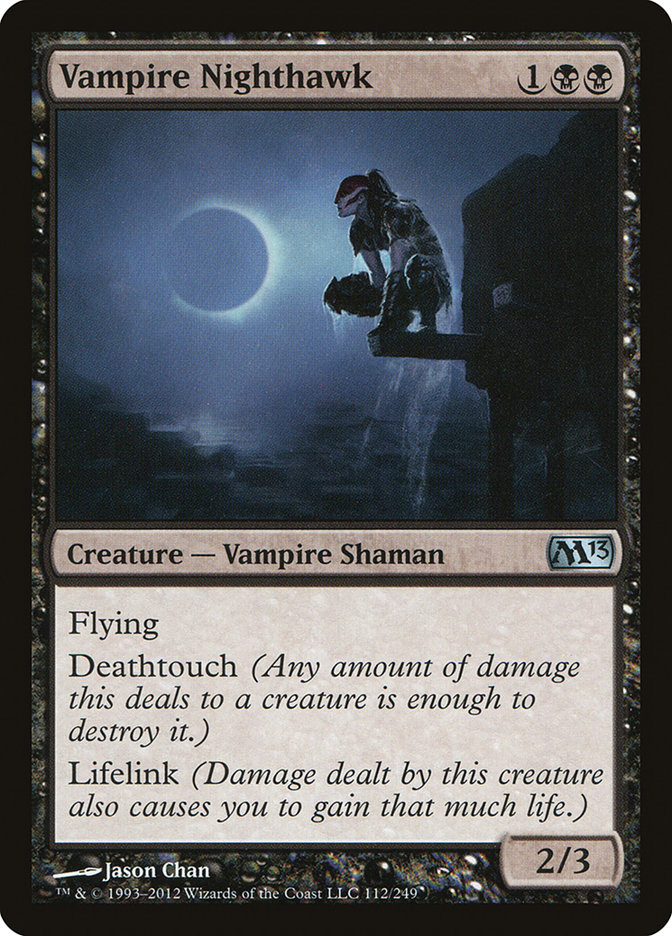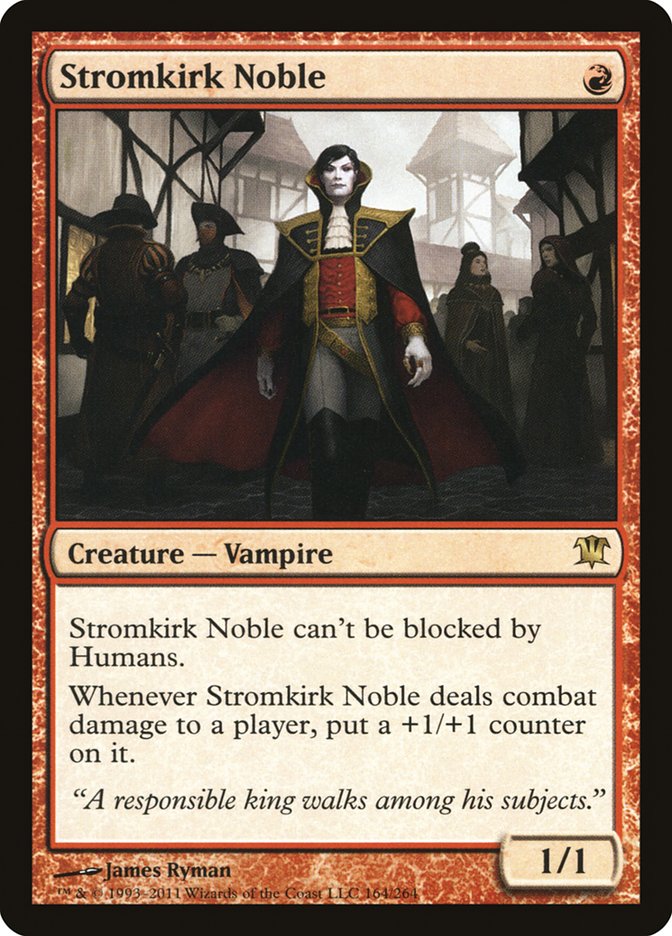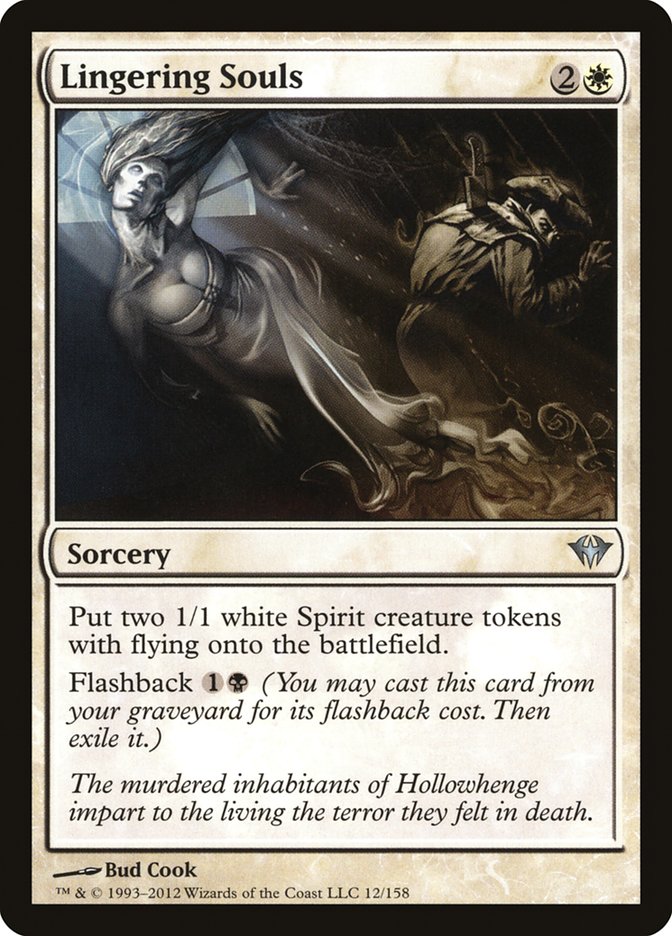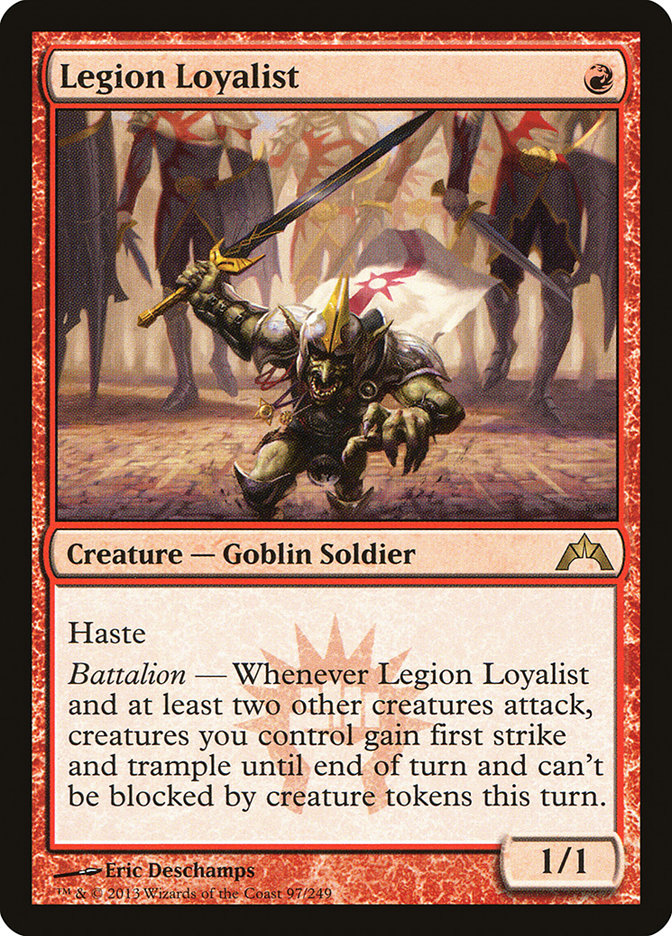Grand Prix Miami is right around the corner, and although it’s extremely unlikely to be as large as GP Las Vegas was, it will definitely be a great one. The Standard metagame seems to be coming to an equilibrium among its best cards and decks, which makes tuning decks easier and allows for better preparation against the field, including mirrors and troublesome matchups. These preparations may cause interesting changes, so let’s look at the ideas driving the metagame. I tend to play aggressive decks, so let’s start there.
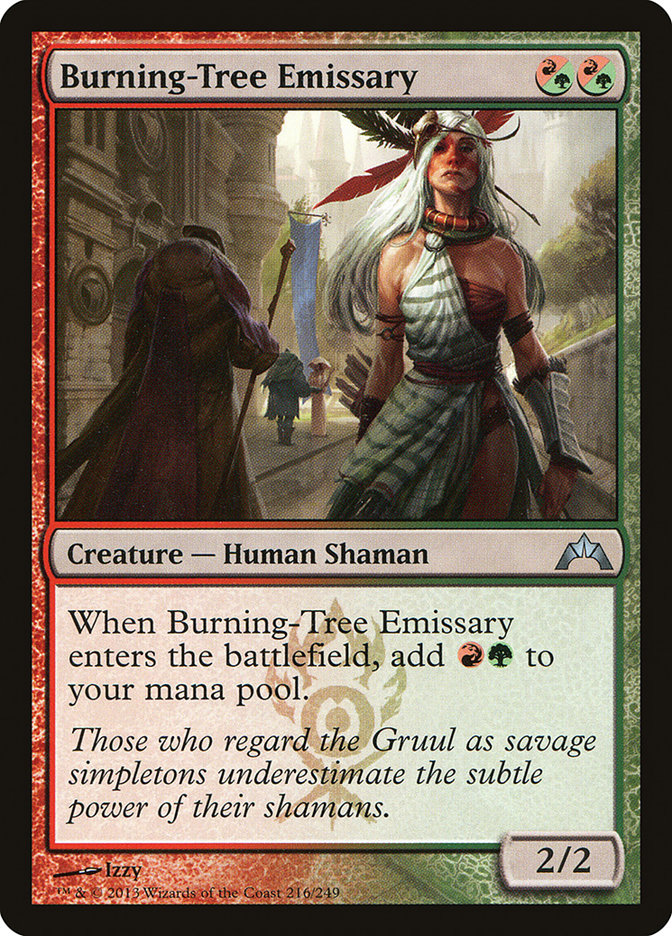 |
vs. |
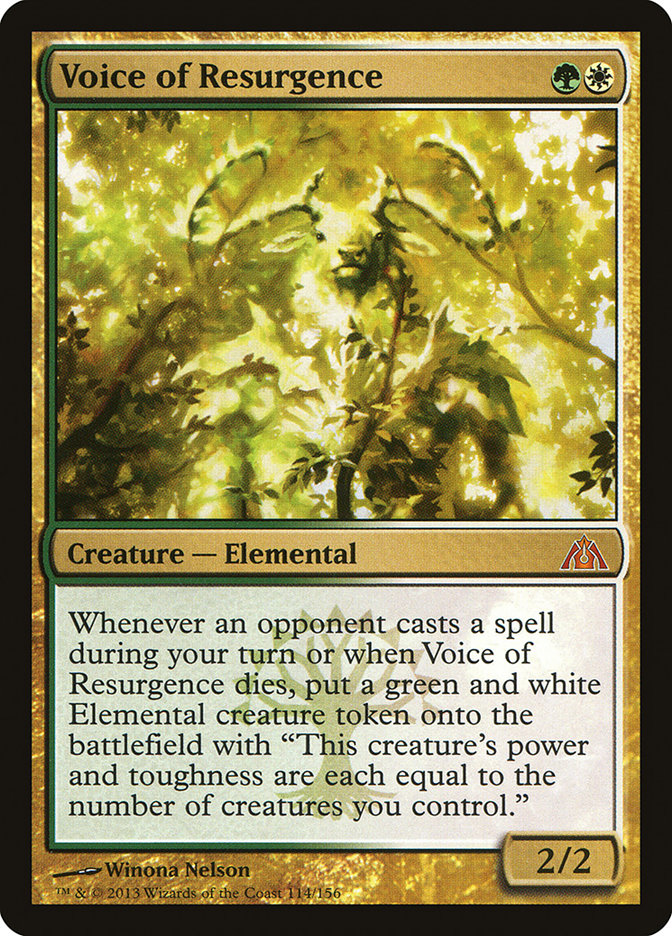 |
I recently had a conversation with a friend who tried to convince me that I should simply find the best Voice of Resurgence deck and play it. This position is very legitimate, but I have an irrational objection to this card, which led me to investigate other good two-drops. The format is divided among fast aggression and various kinds of midrange with both kinds of The Aristocrats playing the role of intermediary. Blue decks come back from time to time, but creatures seem to be superior to spells right now. I’d avoid Sphinx’s Revelation decks as long as Voice of Resurgence stays on top.
The primary choice in the current format is midrange due to its flexibility and card quality. However, you should decide whether your primary goal is to beat other midrange decks or to deal with aggressive decks. Naya Midrange is an example of the former (probably with Aurelia, the Warleader at the top of mana curve), while the latter is represented by Jund. Recent builds of Jund have included Vampire Nighthawk maindeck to support Bonfire of the Damned as a weapon against opposing small creatures; Nighthawk is great in many matchups, such the ability to trade with huge creatures against Bant Hexproof.
Another interesting tech I recently encountered is Wolfir Avenger, which a great blocker and a good way to flip Huntmaster of the Fells and still have a play against aggressive decks. Wolfir Avenger is also good against U/W/x decks, which are on decline now but are still relevant on Magic Online.
How do you beat Jund with an aggressive deck? The first way is to be lightning fast, hope they don’t have a well-timed Bonfire of the Damned, and be ready to deal with the first huge blocker (either Huntmaster of the Fells or Thragtusk). Early red decks used Pyreheart Wolf for that purpose, but a 1/1 for three mana isn’t where an aggressive player wants to be. Gatecrash introduced Firefist Striker, which is a much better 2/1 for two mana and quickly became the industry standard for red decks, ousting both Pyreheart Wolf and Lightning Mauler. Striker trumps Mauler since it helps actually avoid important blockers while barely decreasing the speed of the deck. However, the little Wolf is still decent, and I wouldn’t be surprised to see it again right now.
Another interesting change in red aggressive strategies has many origins. The first of them is the constant displeasure with Stromkirk Noble’s performance; the second is the rise of Lingering Souls (thanks to The Aristocrats and partially Junk Reanimator players returning to their roots instead of packing Acidic Slime). Legion Loyalist is an integral part of Mono-Red Aggro in Block Constructed, and I could see the little Goblin in Standard decks more often. Such a sideboard allows you to deal much more damage through early blockers and significantly improves one of the bad matchups.
Two more ways to deal with troublesome blockers are Madcap Skills, introduced by Gene Richtsmeier in his #SCGSTL Naya Blitz deck, and Gruul War Chant. They both are good against huge blockers rather than hordes of Spirits, but combining them with Legion Loyalist and/or Firefist Striker could be deadly. Gruul War Chant is an interesting beast. It costs four mana, which is a lot. The Chant does its best in two cases: when you have enough pressure to win after casting it and when your creatures are bigger than opposing ones. Wolfir Silverheart seems to be the best creature to play with Gruul War Chant (see: green-based G/R Aggro).
Madcap Skills is better if you can’t afford paying four mana for a noncreature card. Auras are traditionally dangerous for Constructed, but if you look at the best midrange decks, you’ll quickly realize that they have almost no instant speed removal. The Jund deck of John Wallace, who won the StarCityGames.com Standard Open in Columbus, has only four post-board instant spells killing target creature, and Naya decks could easily have Domri Rade and Mizzium Mortars as their only noncreature nonland cards.
So why play Mono-Red Aggro over Naya Blitz? The first reason is consistency. Red decks are a little bit slower, but they aren’t “I have a nut draw and you lose or I don’t and you win.” Red cards are worse than Naya-colored ones, but they’re interchangeable, which allows adjusting their mana curve accordingly to the environment. The second reason is Boros Reckoner, which does its best in aggressive environments and thus allows red deck to beat other aggressive decks. The third reason is Legion Loyalist, which fits into Naya Blitz poorly but is fine in Mono-Red.
Creatures (28)
- 4 Stromkirk Noble
- 4 Hellrider
- 4 Flinthoof Boar
- 4 Rakdos Cackler
- 4 Burning-Tree Emissary
- 4 Ghor-Clan Rampager
- 4 Boros Reckoner
Lands (20)
Spells (12)
Sideboard

Adam Johnson’s list is an interesting example of Mono-Red. He chose to play Madcap Skills over Firefist Striker and added a couple of Gruul War Chants to the sideboard! I don’t think I would like playing so much sideboarded removal in a deck that already has fewer creatures; Mizzium Mortars often comes in for matches where Madcap Skills stays in the deck post-board. I’d rather attack against decks with x/4 creatures than bother killing them, so I’d add some Legion Loyalists and Flames of Firebrand and consider a maindeck split between Firefist Striker and Madcap Skills.
Two more notes about Mono-Red before going to the next deck:
1) Fewer creatures forced Adam to drop Domri Rade from the sideboard. That seems to be correct, especially since control decks are rare these days and Warleader’s Helix, despite being nowhere near its predecessor, is simply insane against planeswalker-based strategies used by aggressive and midrange decks. Domri Rade; Garruk Relentless; Garruk, Primal Hunter; Liliana of the Veil—they all go up to exactly four counters after their first abilities.
2) I watched token decks on Magic Online because they have potential to be good against both aggro and midrange despite the low level of interaction and be the best Voice of Resurgence decks. Legion Loyalist was exactly enough to convince me to drop this idea. It hasn’t made a big appearance at SCG Opens yet, but the Grand Prix metagame is generally closer to the online one, so if you’re planning to play Junk Aristocrats, keep Legion Loyalist in mind.
Despite all its power, Mono-Red Aggro is still weak against Jund with its great creatures and powerful removal. So the question is how to beat Jund with an aggressive deck? It’s hard, but a recipe exists. Jund’s game plan against aggression is to use some early removal, stabilize, and eventually control the battlefield. The weakness is that contemporary Jund decks are almost all sorcery speed; Putrefy is a fine complement to Abrupt Decay, but they usually only have three-to-four copies even post-board.
So the recipe for an aggressive deck that is good against Jund is hasty flyers. I played The Aristocrats at a local tournament last week, and the only time I was happy about what was going on in my matches against Jund was when I cast sideboarded Thundermaw Hellkite right after Falkenrath Aristocrat.
Thundermaw Hellkite seems great in current Standard, and it becomes even better with Lingering Souls increasing in popularity. The huge Dragon even seems like a good idea for Jund Midrange itself and good reason for Naya to try Aurelia, the Warleader.
The Aristocrats: Act 2 isn’t very good at providing early pressure despite being a tempo deck. However, there is a deck that is able to swing fast and then deal the last few points of damage with Falkenrath Aristocrat and Thundermaw Hellkite. Jund Aggro isn’t very popular but seems to be well positioned in the format. Moreover, there are two possible Jund Aggro decks: good ol’ Experiment Jund and the heavier version introduced by Cedric Phillips. Both decks are good against both fast aggression and Naya Midrange, which makes them very legitimate choices. They are also both weak to Bant Hexproof, which is relevant (but what aggro deck isn’t weak to Bant Hexproof?). The difference is that Experiment Jund is generally weaker against Lingering Souls but better against Junk Reanimator.
Creatures (31)
- 3 Borderland Ranger
- 4 Arbor Elf
- 4 Falkenrath Aristocrat
- 4 Thundermaw Hellkite
- 4 Flinthoof Boar
- 4 Burning-Tree Emissary
- 4 Ghor-Clan Rampager
- 4 Gyre Sage
Lands (23)
Spells (6)

Cedric Phillips recently recorded a Versus video against Brad Nelson in which he played this archetype. An interesting note: there are no other black cards aside from Falkenrath Aristocrat and Dreadbore. I’d like to see Putrefy and Olivia Voldaren somewhere in the 75, but if we follow Cedric’s line of deckbuilding, it seems proper to cut black entirely. He came to the idea of Jund Aggro when Hellrider underperformed during G/R testing, but the rise of Lingering Souls makes Hellrider better—and may actually be better than Falkenrath Aristocrat for such a deck, especially if we’re playing four Thundermaw Hellkites as weapons against planeswalkers, Supreme Verdicts, and creature stalemates.
Dreadbore could be exchanged for Mizzium Mortars or for a pair of Domri Rades to provide an edge against midrange. I’d also put a pair of Gruul War Chants in the sideboard.
Experiment Jund has nearly been forgotten, but the deck was built for a Boros Reckoner centric metagame, which is what we’re seeing again right now. Naya, Mono-Red, U/W/R, and even some Reanimator decks play it. Voice of Resurgence doesn’t make the deck built around “third point of toughness matters” worse because most creatures are able to kill Voice and then trade with token, preventing the opponent from gaining an advantage. Experiment One isn’t as good as it was when Supreme Verdict was popular, but there are very few Azorius Charms around now, so Experiment One is a 3/3 more often—which is fine in most cases.
The choice between Falkenrath Aristocrat and Hellrider is much tougher for Experiment Jund, as flyers are badly needed while the metagame has become less and less friendly to Falkenrath Aristocrat. A possible solution is to add some Thundermaw Hellkites to the list. Why not go to the list above? That’s a very legitimate question, but I want to keep a lower mana curve and flexibility. The heavier deck is much more straightforward, sharing the worst downside of Naya Midrange. Experiment Jund, while having about thirty creatures maindeck, can afford more flexible removal and, more importantly, significant change in the post-board game plan. The heavier deck isn’t very good at blocking, much like Naya Midrange.
Creatures (31)
- 3 Mogg Flunkies
- 3 Falkenrath Aristocrat
- 2 Thundermaw Hellkite
- 4 Flinthoof Boar
- 3 Dreg Mangler
- 4 Rakdos Cackler
- 4 Burning-Tree Emissary
- 4 Experiment One
- 4 Ghor-Clan Rampager
Lands (22)
Spells (7)

I’ve also tried Arbor Elf (two or three copies). It supports Thundermaw Hellkite very well, but the deck’s mana curve isn’t great for the little Elf and such a bad late-game topdeck may require Varolz, the Scar-Striped to be affordable. Varolz unfortunately underperformed, and I finally gave him only one slot in the sideboard (against Supreme Verdict). Other experiments with one- and two-mana creatures eventually led me to Cedric’s list, so this build seems to be the most balanced one.
It’s fast enough to crush Junk Reanimator, has enough removal for Boros Reckoner and Loxodon Smiter, is reasonable against Jund and other aggro, and isn’t dead against Bant Hexproof. The last matchup is predictably poor, but the deck at least doesn’t auto-lose to Unflinching Courage (and is a good home for Golgari Charm).
The last reason to look at Jund Aggro is the huge update that will come with M14. It won’t affect deck choice for Grand Prix Miami, but I anticipate a great summer of Magic with Scavenging Ooze, Doom Blade, and maybe even a new dimension of heavier list with both Arbor Elf and Elvish Mystic. Good luck (with some envy from rainy Moscow) to everyone competing at Grand Prix Miami!

